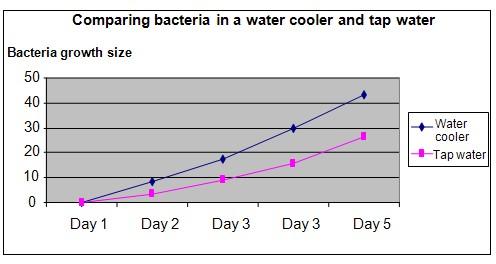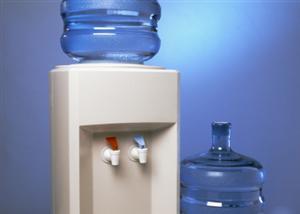| Complexity level: | 8 |
| Project cost ($): | 50 |
| Time required: | 1 day to prepare, 5 days for science fair project |
| Material availability: | Easily found |
| Safety concerns: | The bacteria should be destroyed before being disposed of. Pour some bleach into the petri dish to kill all the bacteria before disposal. |
Hypothesis
The water from a water cooler will contain more bacteria than tap water.
Overview
Bacteria in water coolers and tap water
Water is very important for humans and all living organisms. But the water that we drink also comes with various types of contaminants in the form of microbes and minerals. Among the common minerals found in water are calcium and magnesium. Fluoride is also added to the water to help prevent disease and protect against tooth decay.
A lot of money is spent on bottled water and water filters. Bottled water and filtered water may be bacteria free, but when the water enters the water cooler, it will get contaminated with many types of bacteria. This is because bacteria grows and multiplies quickly in places with high levels of moisture.
Tap water on the other hand contains chlorine. Chlorine is very effective at killing bacteria such as E. coli and other microbes found in water. Chlorine is intentionally added to water by water utility boards, to kill bacteria and prevent water borne diseases from spreading. However, too high a dosage of chlorine in the water can also cause other health problems.
Scientific Terms
Materials
The materials required for the science fair project experiment:
- 2 agar petri dishes
- 2 disinfected swabs
- 1 bottle of disinfected water
- tap water
- 1 water dispenser and water cooler
- 1 marker pen
Procedure
1. For this science fair project, the independent variable is the source of the water – ie: tap water or water cooler water. The dependent variable is the size of the bacteria growth in the petri dishes. This is determined by measuring the size of the bacteria growth using a ruler. The constants (control variables) are room temperature, the amount of sunlight and the ingredients in the petri dish agar.
2. Two petri dishes are prepared and stored in a refrigerator. The petri dishes are brought to room temperature before the start of the science fair project by taking them out of the refrigerator and allowing them to settle at room temperature. The petri dishes are labeled A and B.
3. The sterilized swab is first dampened with sterilized water. The first swab is soaked by placing it under the running tap water and then rubbed across the agar in the petri dish labeled A. The second swab is soaked in water from the water cooler and rubbed across the agar in petri dish B.
4. The cover is closed and the 2 petri dishes are kept in a cool dark place for the bacteria to grow.
5. The size of the bacteria colony is measured for the next 5 days and recorded.

Results
The results showed that tap water had smaller amounts of bacteria compared to water from the water cooler.
|
Petri Dish type |
Size of bacteria growth (mm) |
||||
|
Day 1 |
Day 2 |
Day 3 |
Day 3 |
Day 5 |
|
|
Water cooler |
0 |
8.5 |
17.5 |
29.7 |
43.2 |
|
Tap water |
0 |
3.5 |
9.2 |
15.9 |
26.4 |
The graph below represents the results of our science project experiment.

Conclusion
Our hypothesis has been proven correct - the water from a water cooler will contain more bacteria than tap water.
Tap water is not completely free from bacteria. However it is still considered safer than bottled water.
Also consider
This science fair project may be repeated, this time, with water from different sources such as a water fountain or well.
Try to repeat the science project experiment using water samples from different types of water filters.
References
What's the point in having filtered or bottled water if your water cooler is filled with bacteria? - http://www.electrotemp.com/
The affects of bacteria and minerals in tap water - http://www.ehow.com/about_5173257_effects-bacteria-minerals-tap-water.html

